One of the most famous attractions in Cebu is the Magellan’s Cross. To some, no one should ever leave Cebu without visiting the said place. However, the original of the said cross is encased with a special type of tindalo wood. This is due to the miraculous ability of the cross and due to old age, some parts of it start to deteriorate.
Obviously, the cross is named after the most renowned Portuguese explorer, Ferdinand Magellan. He is the one who put up the cross which symbolized the baptism of Rajah Humabon and his people.
Located in the bustling city of Cebu, Philippines is Magellan’s Cross Pavilion. This stone kiosk lies adjacent to Basilica del Santo Niño and holds a significant Christian cross that was planted by Ferdinand Magellan and his Spanish expedition upon arriving in Cebu on April 21st, 1521 during their first circumnavigation of the world. The national cultural treasure has been declared as such due to its rich history thus making it an important landmark for visitors to learn about this momentous event.
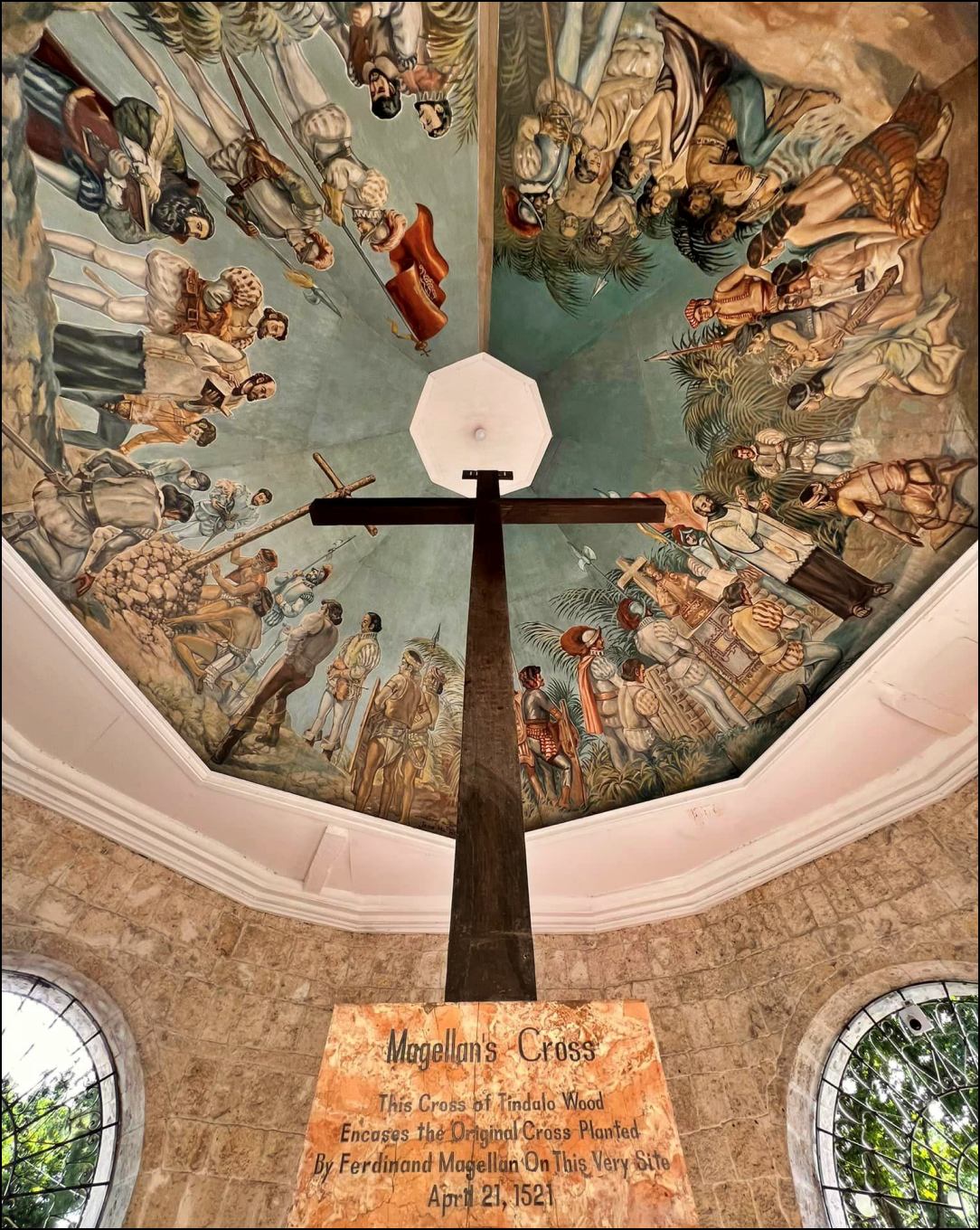
Traveling to unfamiliar places often leads to discovering something extraordinary – a hidden gem that captures your heart and leaves you with an unforgettable experience. While visiting Cebu, the Philippines, one of the city’s most spectacular sights is the Magellan’s Cross.
The mysterious cross has long been regarded as a symbol of Christianity in Cebu and an important antiquity from colonial times; yet few people know its fascinating history. If you’re looking for a travel destination where you can discover a world of secrets and stories, then look no further than Cebu and its Thousand Year-Old Story Adorned With Crosses – join me on this journey as I take a closer look at Magellan’s Cross.
History
In 1800, the Magellan’s Cross was constructed with coral stone and has since come to mark an important milestone in history.
The Old Magellan’s Cross
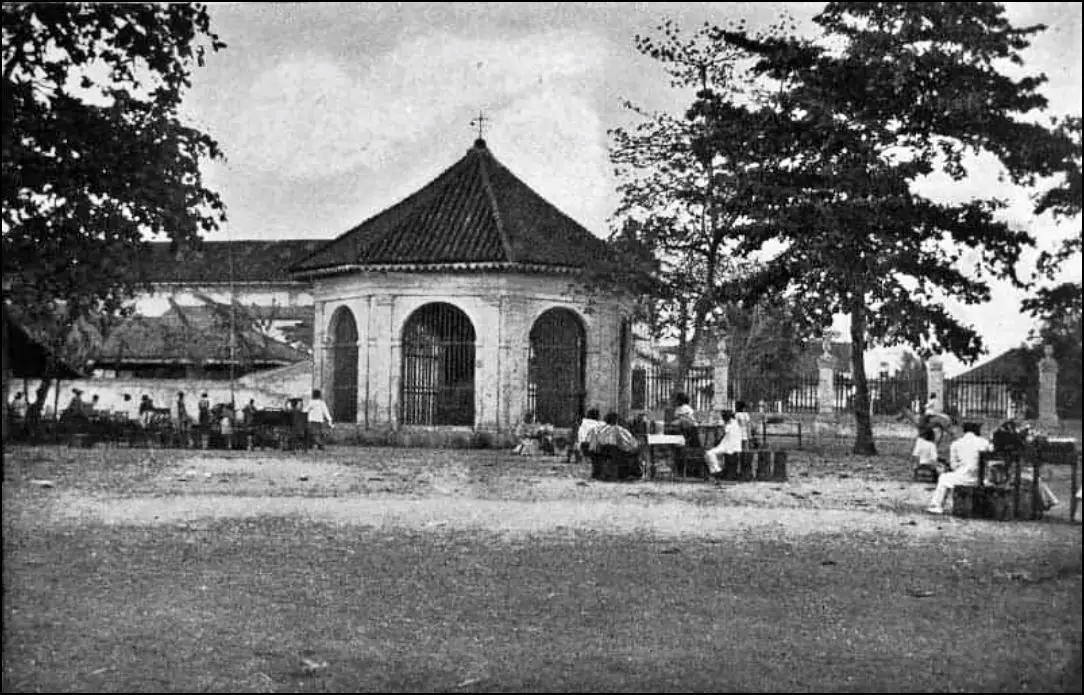
Pavilion
The octagonal coral stone structure, popularly known as the Magellan’s Cross Pavilion, was constructed in the 1800s. Unfortunately, after being rocked by a 2013 earthquake and ravaged by termites two years later, both this pavilion and its famous tindalo cross sustained cracks throughout their surfaces.
In March 2016, the pavilion reopened its doors after renovations. Adorning the ceiling of this wonderous place is a mural commissioned by Jess Roa and Serry M. Josol that encapsulates Rajah Humabon’s baptism led by Father Pedro Valderrama in conjunction with Ferdinand Magellan planting a wooden cross—an event marking both spiritual connection as well as colonization from European countries.
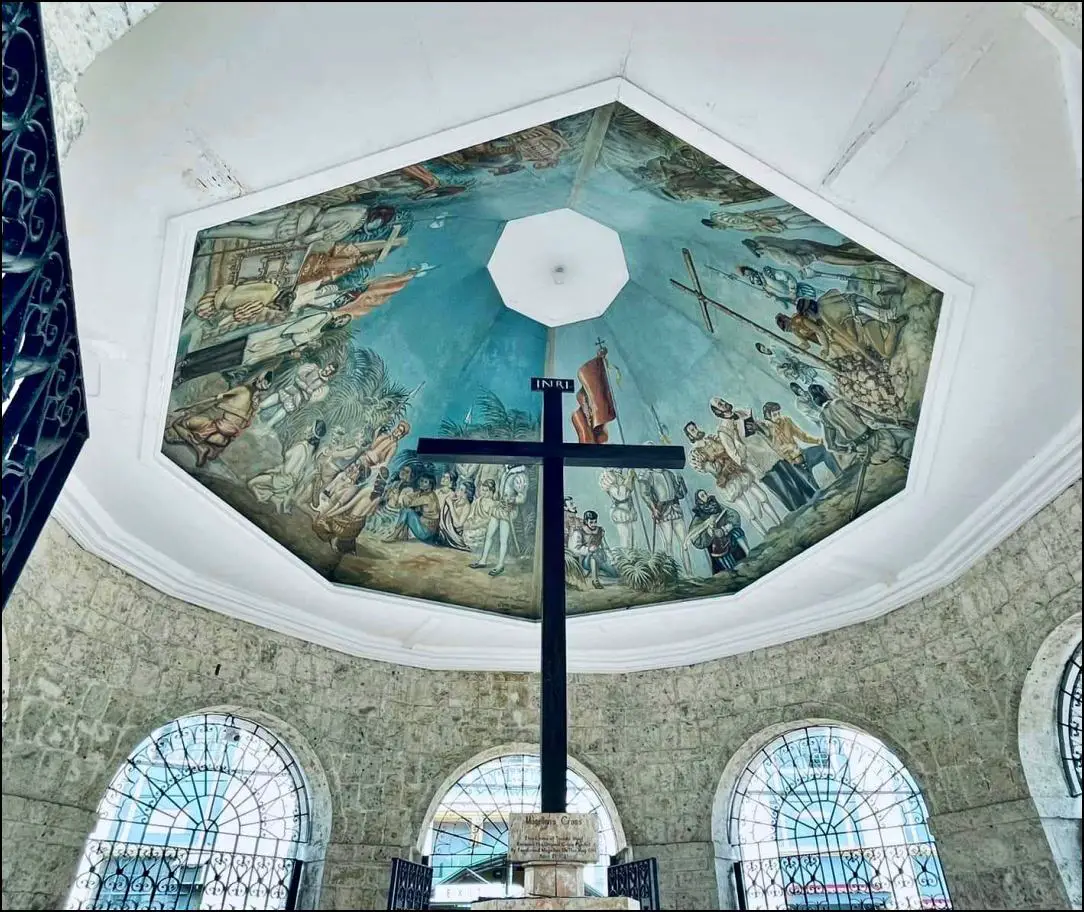
Cross: A Symbol
The cross serves as a symbol of Cebu City. It is also the figure of the city’s government, seals, and logos.
On April 21, 1521, Ferdinand Magellan and his Spanish expedition arrived in the Philippines to complete their momentous journey of circumnavigating the world. To commemorate this historic event, they planted a wooden cross called ‘Magellan’s Cross’ at Cebu – an enduring symbol of courage and exploration.
Ferdinand arrived in the land of Cebu thinking that it was the Spice Islands. But instead of finding the place, he met natives and agreed to baptize them. This is the start of Christianity. In Philippine history, it was also transparent that Ferdinand Magellan lost in the Battle of Mactan at the hands of Datu Lapu-Lapu.
In 1835, the original cross was safeguarded behind another wooden cross constructed from tindalo wood in order to preserve it against those who believed that its pieces had miraculous powers. Nevertheless, others presume that the authentic cross has been destroyed.
There are issues and conspiracy theories saying that the original cross was destroyed long time ago by the natives after the death of Magellan. There are existing narratives indicating that ships were burned together with the original cross. Whatever is the truth, it is yet to unfold.
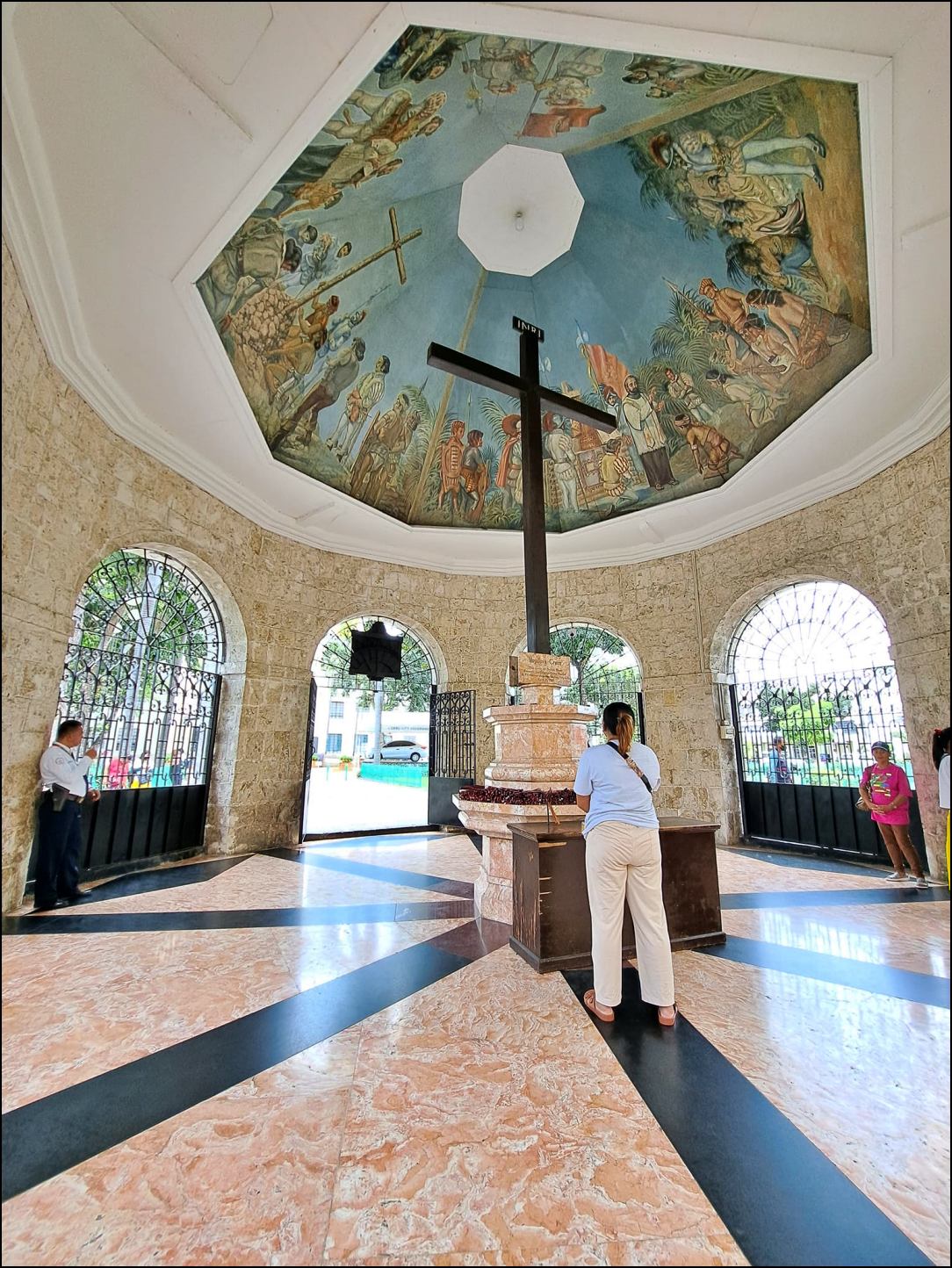
To commemorate the 2021 Quincentennial, a cross has been christened as the “2021 Jubilee Cross” in honor of this historic event.
Designation
On April 14, 2021, the National Museum of the Philippines officially declared that The Pavilion, along with the Basilica del Santo Niño Church and Convent, are now jointly recognized as National Cultural Treasures.
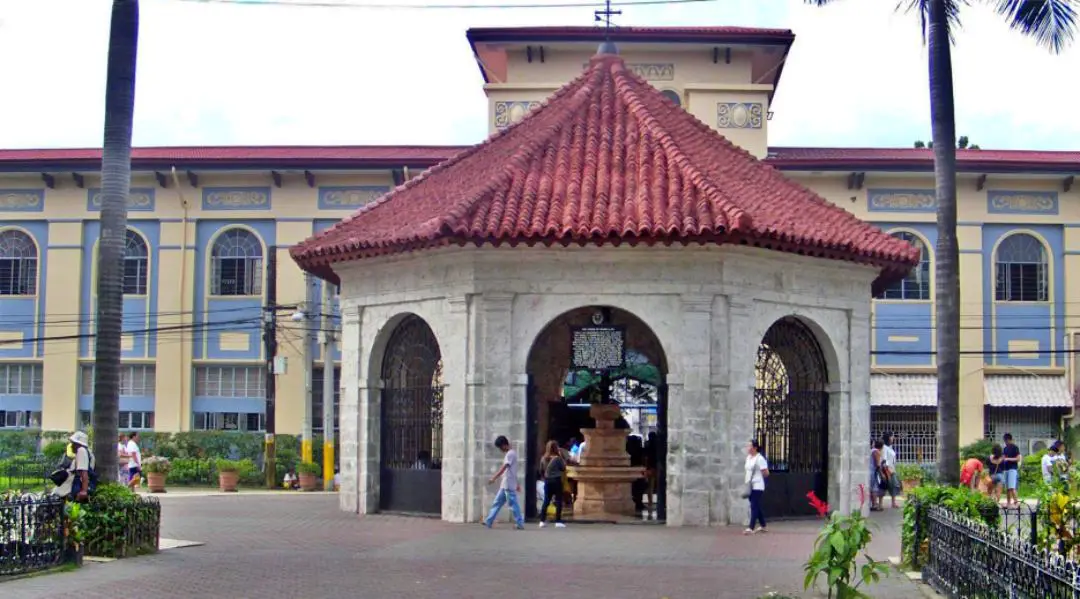
Why do Cebuanos Keep on Visiting Magellan’s Cross?
The locals were convinced that the cross had miraculous powers, so they often paid it a visit in order to gather pieces of it – hoping these fragments would heal them.
Activities inside Magellan’s Cross
Outside the place, vendors sell various colors of candles for prayers. Each color symbolizes a type of prayer. Inside the place, you can see that many believers are praying and waiting for a miracle to happen in their lives. Various colors of candles are lighted up.
When you try to look up at the ceiling, you can see a painting of the very first mass in the Philippines. The painting was done wonderfully and is one of the reasons why people are visiting Magellan’s cross.
Attractions Near Magellan’s Cross
Here are the attractions near Magellan’s Cross that are worth a visit:
-
Minor Basilica of the Holy Child of Cebu (Basilica Del Sto. Niño)
-
Fort San Pedro
-
Heritage of Cebu Monument
-
Cebu Metropolitan Cathedral
-
Casa Gorordo Museum
-
Yap-San Diego Ancestral House
-
Cebu Provincial Museum
-
Plaza Independencia
-
Taboan Public Market
-
Carbon Market
-
Jesuit House Museum
-
Cebu Taoist Temple
-
Archdiocesan Museum of Cebu
How to Get from SM Cebu to Magellan’s cross?
Bus – the most convenient and affordable option is to take a MyBus or Ceres Bus from SM Cebu to the city center. Once you get there, simply ask around for directions to Magellan’s Cross. The landmark is located within the city plaza, so it shouldn’t be too hard to find. It will cost around ₱25 – ₱40 only and the journey should take around 15-20 minutes depending on the traffic.
Taxi – You can take a taxi which will cost you around ₱120 – ₱200 and will take 15 minutes depending on the traffic.
Grab – You can use Grab which should cost you about ₱200 – ₱300 and take about 15 minutes depending on the traffic.
Angkas – You can use Angkas which will cost you around ₱100 – ₱150 and take 10 minutes depending on the traffic.
VIDEO: Magellan’s Cross -The Famous Tourist Spot | Walking Tour
Watch this video to get a glimpse of the famous tourist spot – Magellan’s Cross.
Frequently Asked Questions
1. Is there an admission fee or entrance fee for viewing Magellan’s Cross?
A: No, there is no admission fee to view Magellan’s Cross. It is open for public viewing at no cost. However, donations are accepted and appreciated by the chapel.
2. Is there a special ceremony or ritual involved in visiting Magellan’s Cross?
A: Yes, it is customary to light a candle and make a wish for good luck as part of the tradition when visiting Magellan’s Cross. Visitors are also encouraged to kneel in prayer before the cross.
3. Is there an age limit to visit Magellan’s Cross?
A: No, there is no age limit for visiting Magellan’s Cross. Visitors of all ages are welcome to view the cross and take part in the traditional ceremony. However, children under 10 years old must be accompanied by a responsible adult.
4. Are there any restrictions on taking photos at Magellan’s Cross?
A: No, there are no restrictions on taking photos at Magellan’s Cross. However, visitors are asked to respect the religious nature of the chapel and be mindful when taking pictures.
5. Is there anything else I should know before visiting Magellan’s Cross?
A: Yes, visitors are required to dress modestly while in the chapel. It is important to remain silent and respectful throughout your visit. Lastly, pets are not allowed inside the chapel. Following these rules will help ensure a pleasant experience for all visitors.
Summary
Nestled in the heart of Cebu City, the Philippines, is a historical gem and a must-visit destination for tourists and locals alike – Magellan’s Cross. This revered symbol bears testimony to the arrival of the Portuguese explorer Fernando Magellan in 1521 and the birth of Christianity in the region. Standing tall beneath a beautifully crafted open chapel, the cross is not merely a symbol of faith, but it intertwines history, art, and culture in a fascinating manner.
A visit to Magellan’s Cross promises to transport you back in time, as you witness the intricate paintings on the ceiling that narrate the story of Cebu’s rich past. As you soak in the serenity and marvel at this timeless masterpiece, you find yourself deeply connected to an important piece of the cultural fabric that defines Cebu today.
How to Get There
If you are currently at the Mactan Shrine, you can opt to wait for a multicab that goes to Bag-o or Highway. From there, you can stop at the Mandaue Coliseum and ride a jeepney going to the Cathedral. Once you arrive at the Cathedral, you can now see Magellan’s Cross which is just few steps away from the Sto. Niño Church.
Tourists never forget to visit this place because it is near to other tourist spots like Fort San Pedro and just few rides away from Taoist Temple. The place is also near the city hall and many inns are available for tourists to stay.
The place is open for tourists and visitors from 8 in the morning to 6 in the evening. The entrance fee is free which can help you save a lot.
Contact Information
Magellan’s Cross
Located in: Plaza Sugbo
Address: 7WV2+CQG, P. Burgos St, Cebu City, Cebu
Phone: (078) 945 6321
Hours: 8 AM – 6 PM (Monday – Sunday)
Google Map Location
Please check out the map guide to the location of Magellan’s Cross in Burgos Street, Cebu City: